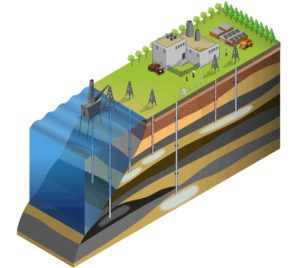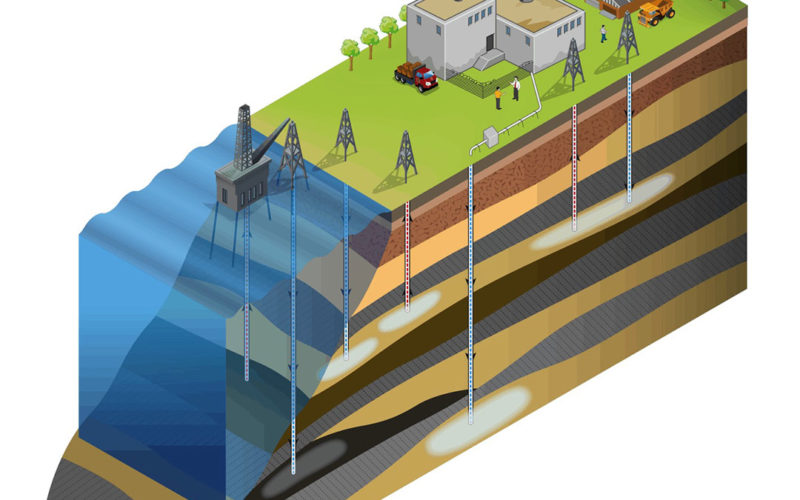
The United Nations Framework Convention on Climate Change adopted the Paris Agreement in 2015 with the intent to peak and then sharply reduce greenhouse gas (GHG) emissions in order to keep the average global temperature rise below 2 degrees Celsius and preferably limited to 1.5 degrees above pre-industrial levels. In response to the U.N. initiative, the International Maritime Organization (IMO) recently set ambitious targets for decarbonization of the global fleet, aiming to reduce carbon dioxide (CO2) emissions from shipping by at least 50 percent by 2050 compared to 2008.
GHG emissions reduction can be achieved in several ways, including carbon capture and storage (CCS). This is the process of capturing waste CO2, usually from large point sources such as power plants or cement factories, and transporting it in liquid or vapor form to a storage site. The Intergovernmental Panel on Climate Change considers CCS an important method of reducing global CO2 emissions.
Most studies concerning carbon capture focus on onshore power plants that use fossil fuels, but it is also a potential supplemental solution for reducing the overall carbon footprint of a vessel or offshore unit. Unless the vessel or unit is using a zero-carbon fuel such as ammonia or hydrogen, other fuels — including liquefied natural gas, liquefied petroleum gas, methanol, biodiesel and renewable diesel — will release CO2 as a byproduct of combustion. CCS for shipboard application refers to a set of technologies that can be used to capture CO2 from the exhaust gas of a vessel or offshore unit and store it for subsequent disposal or use.
Carbon capture methods
Over the past 20 years, many research groups around the world have explored carbon capture technologies to increase efficiency and reduce the size and cost of the systems, which are typically designed for electric power plants. CO2 has been safely transported and used in many industries for decades and can be moved by ship, truck or pipeline. Maritime deployment of CCS is now being researched and piloted by multiple firms.
There are three major types of CO2 capture systems: post-combustion, pre-combustion and oxyfuel combustion. Pre-combustion and oxy-fuel combustion remove carbon from the fuel prior to use and produce hydrogen and oxygen, respectively, for combustion. Consequently, the pre-combustion and oxy-fuel combustion systems require integration into the fuel supply and power generation systems and call for a total redesign. The post-combustion method captures CO2 from flue gas and therefore can be added to a conventional design with minimal alteration to the engine. Retrofitting vessels or offshore units as a standalone system is relatively straightforward.
In the most conventional process, there are two steps to separate CO2 from emissions: capture (sorption) followed by thermal or pressure-swing desorption, also termed regeneration. In capture, the CO2 is absorbed into a liquid or solid by contacting the CO2 source with the absorber. In the desorption/regeneration step, CO2 is selectively desorbed from the absorber, resulting in a flow of pure CO2 gas with the original amine sorbent regenerated for further use.
Rules and standards
Regulations and policies for carbon capture are mostly still in development, with Europe being a notable early adopter. The European Union’s directive on geological storage of carbon dioxide came into force in 2009, providing requirements for this stage of the process. In 2005, the Intergovernmental Panel on Climate Change released a special report on CCS that covers maritime considerations, including the design, construction, operation, risk, safety and cost of systems.
In addition to these initiatives, the United Kingdom’s Department of Energy and Climate Change has projects in motion to support the relatively new technologies. In the United States, the Environmental Protection Agency is working on developing regulations to track national carbon-capture activity and ensure safe practices.
Onboard considerations
The challenge in the offshore environment is the handling and storage of captured CO2. The process requires significant power to liquefy or solidify the captured byproduct, and storing it in gaseous form on board is not a viable option due to space requirements.
CO2 transforms from gas to solid directly when cooled at ambient pressure and solidifies at minus 78 degrees Celsius. It also can be solidified by interaction with other chemicals.
To transport CO2 in a liquid state, it needs to be contained at a pressure of 0.7 megapascals and minus 50 degrees Celsius. If the liquefied CO2 is to be stored on board, the storage space should be determined based on the expected capture during the voyage. One ton of liquefied CO2 occupies about 1 cubic meter of volume.
Current research
Offshore CCS initiatives present CO2 storage opportunities through the use of existing or abandoned wells. Research projects in partnership with the U.S. Bureau of Ocean Energy Management are collecting data on offshore storage complexes along the mid-Atlantic, Southeast and Gulf coasts. These projects use 3D flow and geomechanical modeling to assess sites with the potential to store millions of metric tons of CO2.
Mitsubishi Heavy Industries (MHI) recently conducted a concept study focused on installing a carbon capture and storage unit on a very large crude carrier. The system was comprised of four towers for cooling the exhaust, absorbing CO2, treating the exhaust and regenerating the CO2, in addition to the required liquefaction and storage facilities. The objective of the project was to investigate onboard production of methane or methanol by combining hydrogen from water electrolysis with the captured CO2. MHI reported a CO2 capture rate of about 86 percent and a 20-year rate of return due to the high capital and operating expenses involved.
The United Kingdom’s Department for Transport recently funded a project by PMW Technology, which has partnered with the marine design company Houlder Ltd. to study the potential of using the A3C carbon capture process in shipping. The process involves extracting CO2 from exhaust gases by freezing and subliming it. The CO2 then would be liquefied and stored in tanks on board the ship.
Carbon capture technology is facing many technical and economic challenges for marine and offshore applications. However, it still has potential to be an effective method of reducing GHG emissions from future vessels and offshore units, especially in conjunction with low-carbon fuels. Further technical advances are expected to reduce the scale, cost and complexity of the technology.
The role of ABS
Decarbonization is a major component of sustainability, but sustainability also means supporting businesses in challenging times. Strategies include alternative energy sources for a lower carbon footprint, new approaches to vessel and asset design to enhance performance, and digital solutions to optimize asset management.
Through the Offshore Sustainability Online Resource Center, the American Bureau of Shipping (ABS) addresses operational sustainability, environmental sustainability and digital sustainability. These services are offered in addition to ABS’ classification services that cover the operational safety of production units and unmanned offshore installations, as well as offshore compliance and regulatory issues.
ABS is also working with the Massachusetts Institute of Technology on strategies for emissions reduction and CO2 mitigation. The studies are taking into consideration the size of potential onboard systems for many vessel types, as well as the modeling of system performance for exhaust flow, efficiency and CO2 reduction potential. For more information, visit the ABS sustainability portal at ww2.eagle.org.
Joshua Padeti is a senior engineer in the machinery, electrical and systems engineering group within ABS Technology. His expertise encompasses a wide variety of topics including sustainability, alternative fuels, emissions, environmental compliance, ship machinery, marine piping, statutory compliance, rule development, fire safety, subsea mining and the transfer of class procedures. He has a master of science degree in mechanical engineering from the University of Michigan and a bachelor’s degree in mechanical engineering from Osmania University in Hyderabad, India.

